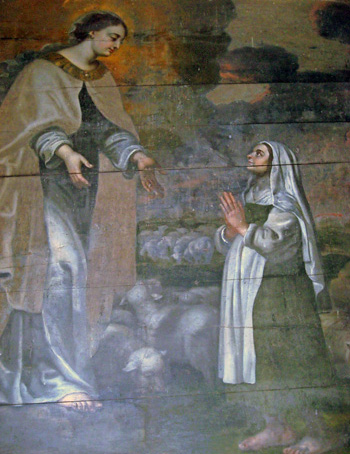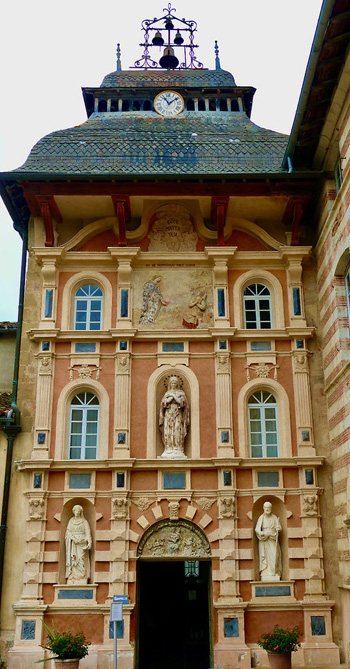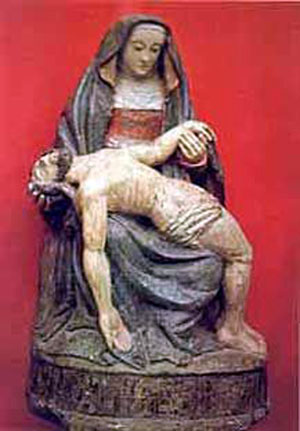Feast Days of Our Lady
 |
 |
 |
 |
 |
 |
 |
Our Lady of Pity of Garaison - March 12
Biographical selection:
The region of Garaison in the province of Gascony was known by the peasants of the area as being a place of terror. For centuries the Devil presided over that muddy area where the witches of Gascony gathered for their Sabbaths. It was a wild flat land of ill-fame, filled with thorn bushes, the refuge of the bandits and ferocious wolves. Yet, this was the place Our Lady chose to appear when a great famine plagued the region.
 In 1515, Angleze de Sagazan, a poor 12-year-old shepherdess, was tending her sheep when a marvelous Lady dressed in white appeared to her with a joyful and affable countenance and told her: "Do not be afraid, I am Mary, the Mother of God. Go, my daughter, and tell your father that I am asking the Rector of Monleon to build a chapel here because I have chosen this place to spread my gifts."
In 1515, Angleze de Sagazan, a poor 12-year-old shepherdess, was tending her sheep when a marvelous Lady dressed in white appeared to her with a joyful and affable countenance and told her: "Do not be afraid, I am Mary, the Mother of God. Go, my daughter, and tell your father that I am asking the Rector of Monleon to build a chapel here because I have chosen this place to spread my gifts."
Angleze had never lied, and her father did not hesitate to carry the message to the Rector, who asked for a sign as proof of the authenticity of the apparition.
The next day Our Lady visited the girl again, and Angleze told her what the Rector had requested. The Lady told her: "Go and look at your satchel and in the barn," and disappeared.
Angleze looked at her satchel that should have contained a piece of dark bread and instead found beautiful white bread. The barn, which was empty until that moment, was overflowing with grains of wheat.
The Rector surrendered before this evidence. A solemn procession was organized to bring a Cross to the cursed place. In 1540, a chapel was built in honor of Our Lady of Pity of Garaison, which became an important place of pilgrimage in France.
Comments of Prof. Plinio:
You find here, at first glance, a story similar to many others related to apparitions of Our Lady. There is a cursed place and Our Lady affirms her triumph there. She gives a message, which is at first not believed by authorities who want proofs. The proofs are given in an exuberant way. The message is accepted; a Sanctuary is built, and Our Lady starts to diffuse her graces.
There are some details in this particular history that, precisely because of their similarity to others, reveal a custom of Our Lady, which – since it is a custom of hers – is very dear to us.
 First there is the fact that Our Lady appeared in a cursed place that was infested by the Devil. After his fall the Devil is akin to everything bad, ugly and wrong in nature. He thus tends to manifest himself especially in these ugly and horrendous places.
First there is the fact that Our Lady appeared in a cursed place that was infested by the Devil. After his fall the Devil is akin to everything bad, ugly and wrong in nature. He thus tends to manifest himself especially in these ugly and horrendous places.
In Garaison he appeared in the muddy marshes, probably moving the mud to make horrific phantoms to scare the people. Mud is a symbol of vice; when we want to describe a depraved soul, we say: "He has a muddy soul."
In this regard St. Thomas teaches us something very interesting: He says that after the Final Judgment when the reprobates will be cast into Hell, all the vile matters of earth will also be thrown in. Then, mud and all kinds of filthy materials will be thrown into Hell. There will be a universal fire on earth that will burn every corruptible thing and the wreckage will be thrown into Hell.
This helps us to understand how the Devil feels at home when he finds these ugly places on earth. This also explains why the Sabbath rituals take place in those filthy sites.
 Then, Our Lady decides to reign in Garaison. What does this mean? It is a manifestation of her power in a special way: She takes the filthiest possible thing and completely regenerates it.
This gives us hope.
Then, Our Lady decides to reign in Garaison. What does this mean? It is a manifestation of her power in a special way: She takes the filthiest possible thing and completely regenerates it.
This gives us hope.
The more tempted our souls are, the more we must trust Our Lady. She is capable of fiercely defeating the spirit of darkness without any effort, because she is Queen of all Creation. The Devil has terror of her. She can break the power of the Devil and can impose her dominium, her sovereignty, any place that she chooses. She takes such actions for us to understand that the most persistent Devil is nothing if the person knows how to have recourse to her.
Further, Our Lady indicates in this apparition that she can take a muddy and sinful soul and transform it into a sanctuary.
It was due to her prayer that Our Lord transformed water into wine at the wedding of Cana; so also she can ask such abundant graces for a soul that the most disgusting and infested soul can become a soul of Our Lady. This is the reality symbolized by the fact that Our Lady ordered a Sanctuary to be built in that infested swamp.
The fact that Our Lady appeared to a little shepherd girl shows us her insistence in appearing to innocent simple country persons. Why? Because in the cities people are looking at making money and become sensual. In the countryside it is easier to live a holy life.
St. Vincent of Paul, who was from a family of very simple peasants, was highly regarded by the nobles of the French court, and Queen Anne of Austria made him her spiritual counselor. When some of his relatives approached St. Vincent to ask him to find jobs for them in the city, he answered: "Do not count on me for that. I will never take my relatives from the countryside, where they can save themselves more easily, to put them in the city, where they would have a hard time to be saved."
In Garaison Our Lady appears to a little shepherd girl to stress this truth: These simple shepherds have more open, disinterested and natural souls.
While the Devil is akin to mud and filthiness, what are the works of Our Lady? They are marvels! The authority asked her for a sign, and she sent them: one minuscule, another enormous.
 The minuscule was the bread. The girl looked in her satchel and found white bread replacing her dark bread. In Europe dark bread is the bread of the poor and white bread is the bread of the rich. So, for Angleze it was a treat to find a beautiful white bread in her satchel. The enormous sign was the barn, it was not filled just with one or two sacks of wheat, but it was overflowing with sacks of an excellent wheat.
The minuscule was the bread. The girl looked in her satchel and found white bread replacing her dark bread. In Europe dark bread is the bread of the poor and white bread is the bread of the rich. So, for Angleze it was a treat to find a beautiful white bread in her satchel. The enormous sign was the barn, it was not filled just with one or two sacks of wheat, but it was overflowing with sacks of an excellent wheat.
It is a manifestation of the generosity of Our Lady. She is the Mother of Mercy. If she gave wheat, which is a small thing next to eternal life, how much more generous she will be with the graces she gives! We need only to ask, and we will receive.
You see how many teachings are contained in this simple episode, so beautiful in its simplicity. They lead us to two considerations:
First, we should face the Devil with courage, not based on our own power because he is an angelic spirit, immensely stronger, more lucid and powerful than us, but rather relying on the power of Our Lady.
Second, we should blindly trust in the protection of Our Lady for our own spiritual and material needs, for the needs of our neighbor and for the needs of the Holy Catholic, Apostolic and Roman Church, today the greater beggar on earth, abandoned, denied, despised and disfigured.
It is the Church who is by right the Queen of the world and the center of all the beauties of the Universe! Let us have pity on the Holy Church today and ask Our Lady to give her all the graces that we conceive moved by the love we owe to the Church.



The Saint of the Day features highlights from the lives of saints based on comments made by the late Prof. Plinio Corrêa de Oliveira. Following the example of St. John Bosco who used to make similar talks for the boys of his College, each evening it was Prof. Plinio’s custom to make a short commentary on the lives of the next day’s saint in a meeting for youth in order to encourage them in the practice of virtue and love for the Catholic Church. TIA thought that its readers could profit from these valuable commentaries.
The texts of both the biographical data and the comments come from personal notes taken by Atila S. Guimarães from 1964 to 1995. Given the fact that the source is a personal notebook, it is possible that at times the biographic notes transcribed here will not rigorously follow the original text read by Prof. Plinio. The commentaries have also been adapted and translated for TIA’s site.
The region of Garaison in the province of Gascony was known by the peasants of the area as being a place of terror. For centuries the Devil presided over that muddy area where the witches of Gascony gathered for their Sabbaths. It was a wild flat land of ill-fame, filled with thorn bushes, the refuge of the bandits and ferocious wolves. Yet, this was the place Our Lady chose to appear when a great famine plagued the region.

Our Lady appears to a shepherd girl & asks for a chapel to built in an infested swamp
Angleze had never lied, and her father did not hesitate to carry the message to the Rector, who asked for a sign as proof of the authenticity of the apparition.
The next day Our Lady visited the girl again, and Angleze told her what the Rector had requested. The Lady told her: "Go and look at your satchel and in the barn," and disappeared.
Angleze looked at her satchel that should have contained a piece of dark bread and instead found beautiful white bread. The barn, which was empty until that moment, was overflowing with grains of wheat.
The Rector surrendered before this evidence. A solemn procession was organized to bring a Cross to the cursed place. In 1540, a chapel was built in honor of Our Lady of Pity of Garaison, which became an important place of pilgrimage in France.
Comments of Prof. Plinio:
You find here, at first glance, a story similar to many others related to apparitions of Our Lady. There is a cursed place and Our Lady affirms her triumph there. She gives a message, which is at first not believed by authorities who want proofs. The proofs are given in an exuberant way. The message is accepted; a Sanctuary is built, and Our Lady starts to diffuse her graces.
There are some details in this particular history that, precisely because of their similarity to others, reveal a custom of Our Lady, which – since it is a custom of hers – is very dear to us.

The Devil feels at home in ugly places; above, a haunted house in Kentucky
In Garaison he appeared in the muddy marshes, probably moving the mud to make horrific phantoms to scare the people. Mud is a symbol of vice; when we want to describe a depraved soul, we say: "He has a muddy soul."
In this regard St. Thomas teaches us something very interesting: He says that after the Final Judgment when the reprobates will be cast into Hell, all the vile matters of earth will also be thrown in. Then, mud and all kinds of filthy materials will be thrown into Hell. There will be a universal fire on earth that will burn every corruptible thing and the wreckage will be thrown into Hell.
This helps us to understand how the Devil feels at home when he finds these ugly places on earth. This also explains why the Sabbath rituals take place in those filthy sites.

The 16th century chapel of Our Lady of Pity of Garaison
The more tempted our souls are, the more we must trust Our Lady. She is capable of fiercely defeating the spirit of darkness without any effort, because she is Queen of all Creation. The Devil has terror of her. She can break the power of the Devil and can impose her dominium, her sovereignty, any place that she chooses. She takes such actions for us to understand that the most persistent Devil is nothing if the person knows how to have recourse to her.
Further, Our Lady indicates in this apparition that she can take a muddy and sinful soul and transform it into a sanctuary.
It was due to her prayer that Our Lord transformed water into wine at the wedding of Cana; so also she can ask such abundant graces for a soul that the most disgusting and infested soul can become a soul of Our Lady. This is the reality symbolized by the fact that Our Lady ordered a Sanctuary to be built in that infested swamp.
The fact that Our Lady appeared to a little shepherd girl shows us her insistence in appearing to innocent simple country persons. Why? Because in the cities people are looking at making money and become sensual. In the countryside it is easier to live a holy life.
St. Vincent of Paul, who was from a family of very simple peasants, was highly regarded by the nobles of the French court, and Queen Anne of Austria made him her spiritual counselor. When some of his relatives approached St. Vincent to ask him to find jobs for them in the city, he answered: "Do not count on me for that. I will never take my relatives from the countryside, where they can save themselves more easily, to put them in the city, where they would have a hard time to be saved."
In Garaison Our Lady appears to a little shepherd girl to stress this truth: These simple shepherds have more open, disinterested and natural souls.
While the Devil is akin to mud and filthiness, what are the works of Our Lady? They are marvels! The authority asked her for a sign, and she sent them: one minuscule, another enormous.

In 1590, the Huguenots vandalized the sanctuary & threw the cedar Pieta statue into a brazier: it was removed intact after 2 hours
It is a manifestation of the generosity of Our Lady. She is the Mother of Mercy. If she gave wheat, which is a small thing next to eternal life, how much more generous she will be with the graces she gives! We need only to ask, and we will receive.
You see how many teachings are contained in this simple episode, so beautiful in its simplicity. They lead us to two considerations:
First, we should face the Devil with courage, not based on our own power because he is an angelic spirit, immensely stronger, more lucid and powerful than us, but rather relying on the power of Our Lady.
Second, we should blindly trust in the protection of Our Lady for our own spiritual and material needs, for the needs of our neighbor and for the needs of the Holy Catholic, Apostolic and Roman Church, today the greater beggar on earth, abandoned, denied, despised and disfigured.
It is the Church who is by right the Queen of the world and the center of all the beauties of the Universe! Let us have pity on the Holy Church today and ask Our Lady to give her all the graces that we conceive moved by the love we owe to the Church.

A plaque outside the Sanctuary telling its miraculous origins

 | |
|
|
The texts of both the biographical data and the comments come from personal notes taken by Atila S. Guimarães from 1964 to 1995. Given the fact that the source is a personal notebook, it is possible that at times the biographic notes transcribed here will not rigorously follow the original text read by Prof. Plinio. The commentaries have also been adapted and translated for TIA’s site.


